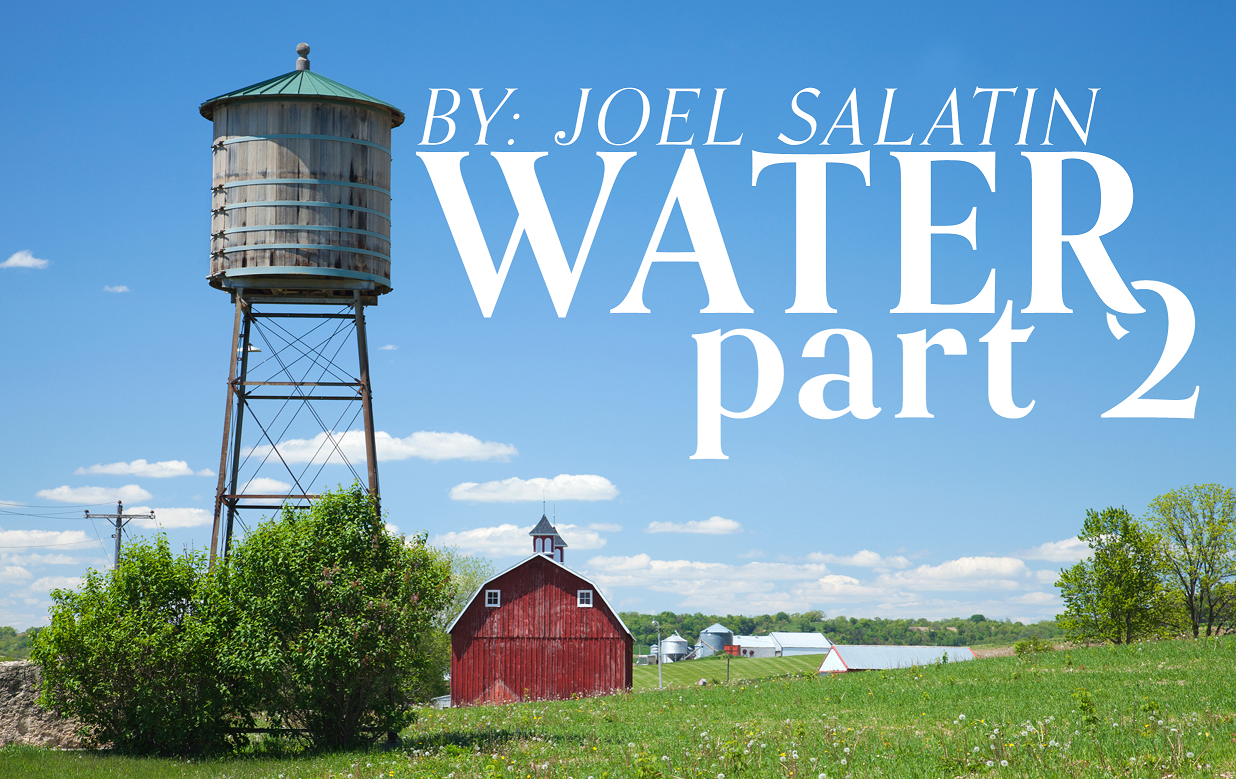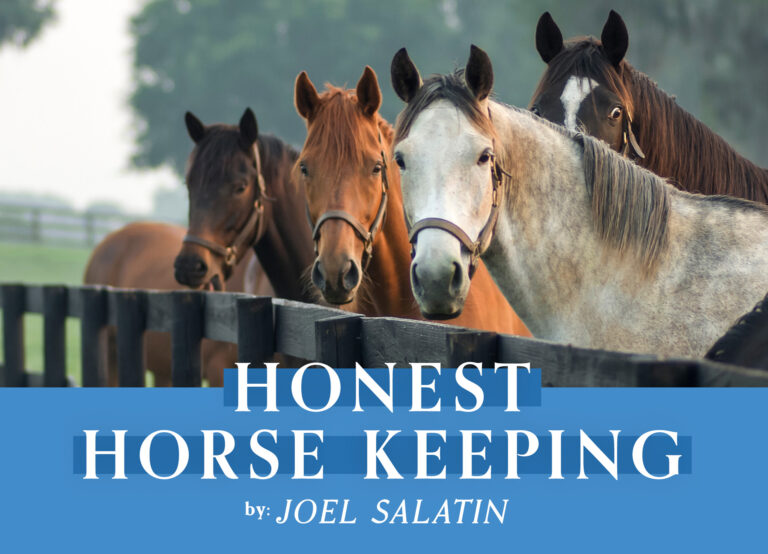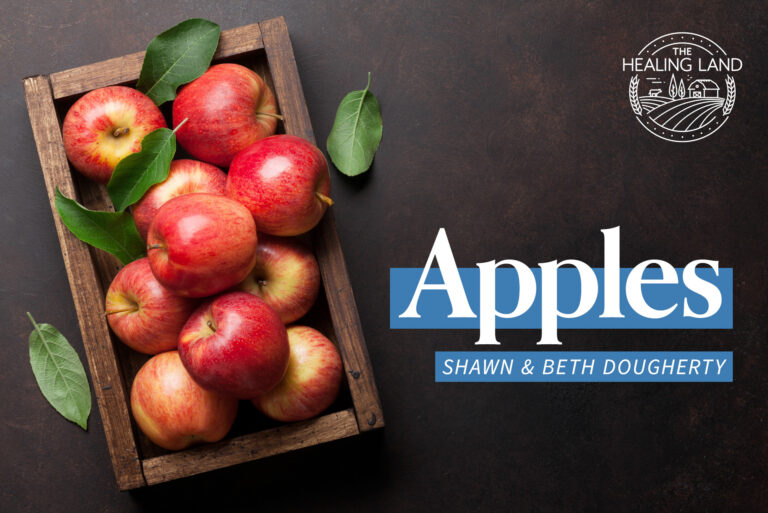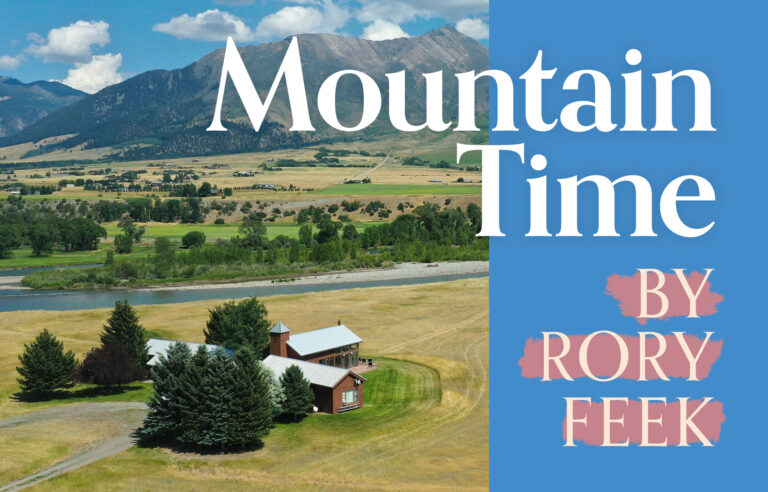by Joel Salatin, Plain Values
Last month I introduced two unorthodox concepts regarding water. The first is the difference between surface runoff and the inventory of the commons (like streams, springs, and aquifers). The second is the notion that we as caretakers can greatly enhance the commons by storing surface runoff rather than pumping from the commons.
We established that one-third of all rainfall globally becomes surface runoff, which means that even a one-acre watershed in a 30-inch rainfall area will generate 10 acre-inches of surface runoff per year, or 300,000 gallons. Another surface we generally don’t think about is our impervious shelter surfaces called roofs.
A 30-inch rainfall zone generates about 20 gallons of water per square foot of roof. So a simple 2,000-square-foot outbuilding or home in such a climate would collect 40,000 gallons of water a year. How many square feet of roof does your farm have? In many cases, if we include equipment sheds, barns, and the house, it’s 10,000 square feet or more. In these instances, we could collect 200,000 gallons of water per year. That means we could use nearly 550 gallons a day, assuming we could store enough.
Long ago in our area, farms depended on cisterns more than wells because in a limestone geology, digging wells is difficult. In sand substrate like much of the Midwest, wells are easy. Not in rock strata. Most farms depended on streams or springs for their water and supplemented with a cistern at the barn. In those days, digging a large cistern was cheaper than trying to dig a well through solid rock.
Both cisterns and ponds add water to the resource inventory, which is part of good stewardship. Depleting the resource inventory (commons) is not the direction a steward should go. With that established, the next major goal for cisterns and ponds is location, which should be as high in elevation as possible.
From this water inventory, a piping distribution system delivers the water throughout the property. What propels water through a pipe is pressure. Conventional thinking immediately assumes a pressure tank and pump system. All latent pressure, except gravity, requires energy. Like a coiled spring, maintaining that real-time pressure adds a lot of costs, switches, sensors, and high-tech infrastructure. Gravity costs nothing.
The farm water problem can be summed up simply: dribbles don’t work in real-time. When you want to fill a bucket of water, you can’t stand there and wait on dribbles. When the cow herd comes to drink, dribbles won’t satisfy. But dribbles do add up over time. Even an extremely small constant flow accumulates. A one-gallon per minute (GPM) flow is virtually a dribble but adds up to 60 gallons an hour and 1,440 gallons a day. That’s substantial on a flow no bigger than a pencil.
The problem is real-time delivery. Again, you can’t wait on a one-gallon-per-minute flow to fill your water bucket or satisfy the cows, even though that dribble over a day is more than enough to satisfy major water uses. In general, the cheapest way to dispense large flows in real-time is to dribble into high terrain storage that uses gravity to pressurize the system and generate high momentary flow.
One of the most elegant domestic water systems I ever saw was a friend who had a rain catchment system from his house roof that flowed into an underground cistern. He hooked up a bicycle to a water pump and in 5 minutes a day could “ride” enough water to an attic cistern to meet each day’s water requirements. The 200-gallon tank in the attic gravity flowed to the hot water tank, shower, and toilet without any pumps or pressure tanks. The only energy required in the system was a 5-minute daily bike ride.
Gravity pressurizes water at .432 pounds per vertical foot. While 10 feet at 4.3 pounds of pressure doesn’t sound like much, it’s enough. If you had a nearby tree you could pull an IBC tote up 40 feet, and get nearly 20 pounds of pressure by gravity. This is why cities use water towers. They can dribble (relatively) water 24 hours a day and use gravity to supply momentary flow when everyone comes home from work and takes a shower.
We leased a farm one time that dribbled water into a tank we put on some poles just to give us enough elevation to start the system. A few pounds of pressure can make a big difference in flow. When water begins to flow through a pipe, friction on the edges works against the flow rate. Often if you increase pipe diameter you can operate on half the necessary pressure to get the momentary flow you need.
On our farm, a group of 20 pastured broiler shelters may need 100 gallons of water at chore time servicing. We use small tubing and a float valve to dribble water into 100-gallon stock tanks that we dip from for that servicing. As long as the tank refills by the next chore time, we have plenty of water on hand. Dribbling is fine if you can catch it.
Probably the most valuable infrastructure on our farm is something nobody sees: 8 miles of buried water lines along the edges of all the fields. From high ground (we have 1,000 feet of elevation change on our farm) we’ve built surface runoff ponds over the years that feed this distribution network at 200 feet of head. That gives us 70-pound pressure water with gravity; no electricity, switches, pumps, or pressure tanks.
The best water from a pond is 16 inches below the surface. If you pull water off the bottom, it’s anaerobic and a bit funky. If you pull it off the top it’ll have fly legs and twigs. With a simple floating bucket and a piece of iron, we situate the intake strainer so it stays at 16 inches below the surface regardless of water elevation. Since the ponds are not in streams, they fill during the winter and gradually deplete during the summer. A series of ponds are hooked together so we can switch from one to the other in case one fully drains.
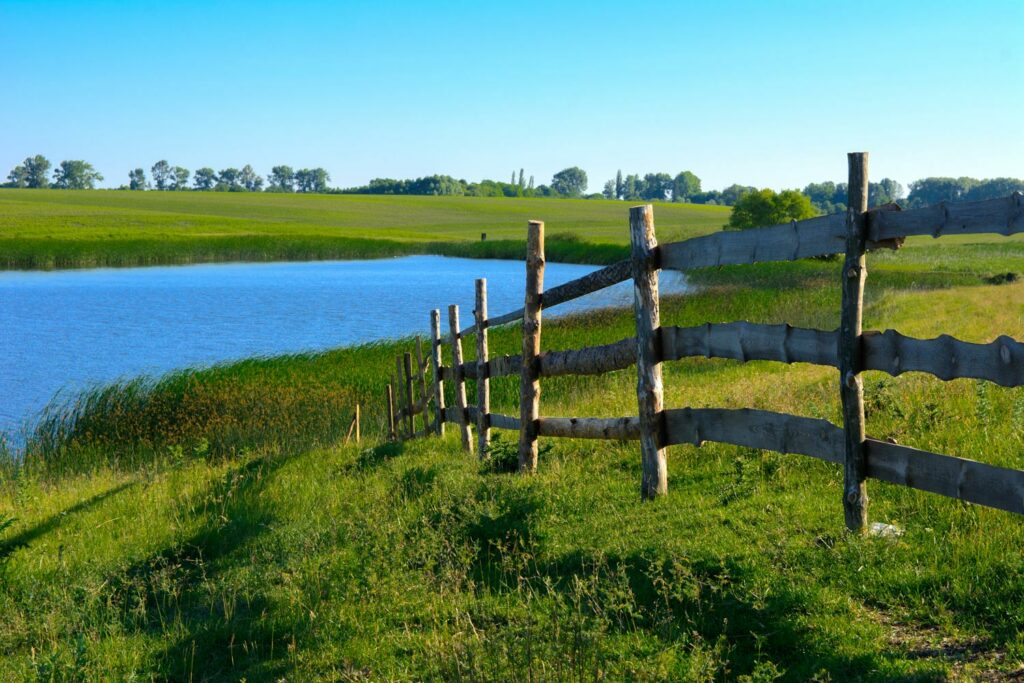
Few things are more enjoyable than watching these ponds fill during heavy runoff events. Not only do we have the satisfaction of watching our inventory replenish, but we also know that we are protecting our downstream neighbors from at least a portion of flooding damage. Meanwhile, the aquifer is intact.
No farmer can afford to haul water. Piping is cheap and accessible enough that the days of hauling water are long gone. Black plastic pipe, even 1½ inch in diameter, is relatively cheap and perhaps one of the best investments you can ever make on your land. The pond/cistern/piping combination is perhaps the ultimate redemptive activity on the landscape.
If water is the beginning of life, then its protection, storage, and development rank high on the checklist to ensure abundant life. Even if you’re located in a relatively dry area that gets only 9 inches of rainfall a year, that’s still 3 inches of runoff and 90,000 gallons per acre per year. Something as small as a 5-acre watershed, even in that dry area, would generate 450,000 gallons of water per year. Assuming 50,000 gallons of water evaporates before it can be used, that’s still 400,000 gallons, or more than 1,000 gallons of usable water per day for livestock and irrigation.
In food and fiber production, water is far more valuable than money; it’s the basis for all biological functions. Part of extending redemptive capacity into the landscape is preparing for droughts and floods. They will happen no matter what we do. Building forgiveness into the landscape to be able to ameliorate the damage and leverage the difficulty is the steward’s mandate.
Every landscape is different. Sometimes a turkey nest pond is the best approach. That’s simply an excavated pond at the top of a hill that you artificially fill as needed. A friend in Australia, where elevation is a challenge, built one that is a couple hundred yards from a valley where he built a catchment pond. Once a month he fires up a little gasoline-powered pump servicing a 2-inch line to the elevated pond on the hilltop. That elevated pond runs his livestock water and irrigation with gravity, which means no latent energy or capital costs in maintaining real-time pressure and infrastructure for immediate flow. With his big 2-inch feed line, that little 1-horsepower gasoline pump sends 50 gallons a minute into the hilltop pond. By the time the gas tank runs dry in 6 hours, he’s pumped 18,000 gallons into the earthen reservoir.
If you’re coming to a new property and wondering about building placement, thinking about elevation can help you leverage roof runoff to a cistern. All of these gravity-based techniques center around using energy (gravity) that is free 24/7/365 to generate pressure rather than artificially generating it with pressure tanks and purchased power. On our farm, as long as gravity works (and when it doesn’t, I’m out of here) we have water. No pumps to go out. No power failure. Water always runs downhill.
One added benefit of pond and cistern water inventories is that I can measure my inventory at any time. In our area, wells routinely fail. Especially in a serious drought, people wake up one morning and their well water is muddy. By the end of the week, the well is dry. But I can go out any day and visit my ponds to check my inventory.
Furthermore, the ponds offer riparian habitat for waterfowl and wildlife. They’re breeding grounds for salamanders and newts. One of the great challenges of our day is to create commercial agriculture models that synergize with wildlife. That’s a good topic for a future column.
Until then, duplicate the beavers and build some water catchments. They build forgiveness into the landscape, provide homes for lots of critters, and bless all the needs for life abundance. Hydrating your farm landscape is one of the best investments you can make. //
This article was published in the June 2022 issue of Plain Values Magazine. If you want the latest stories every month, subscribe to the magazine HERE. As a special thanks, get 10% off your subscription with the code “GAB23”!

Joel Salatin co-owns, with his family, Polyface Farm in Swoope, Virginia. Four generations of his family currently live and work on the farm, and his farm services more than 5,000 families, 50 restaurants, 10 retail outlets, and a farmers’ market with salad bar beef, pigaerator pork, pastured poultry, and forestry products. When he’s not on the road speaking, he’s at home on the farm, keeping the callouses on his hands and dirt under his fingernails, mentoring young people, inspiring visitors, and promoting local, regenerative food and farming systems. Salatin has published 15 books, and he is the editor of The Stockman Grass Farmer, granddaddy catalyst for the grass farming movement. He passionately defends small farms, local food systems, and the right to opt out of the conventional food paradigm.


